How to Zest a Lemon
Published Jun 16, 2023
Learn four easy ways to zest a lemon in this step-by-step guide, bringing a burst of citrus goodness to your dishes.
This post may contain affiliate links. Please read our disclosure policy.
Learn how to zest a lemon in four different ways. This quick and easy tutorial will teach you how to make lemon zest using kitchen tools you already have. Whether you use a microplane zester, box grater, vegetable peeler, or a simple paring knife, you’ll be surprised how easy it is to get major flavor from lemons. Use lemon zest in homemade lemon pepper seasoning, baked goods, sauces, dressings, or desserts to add a burst of citrus flavor.
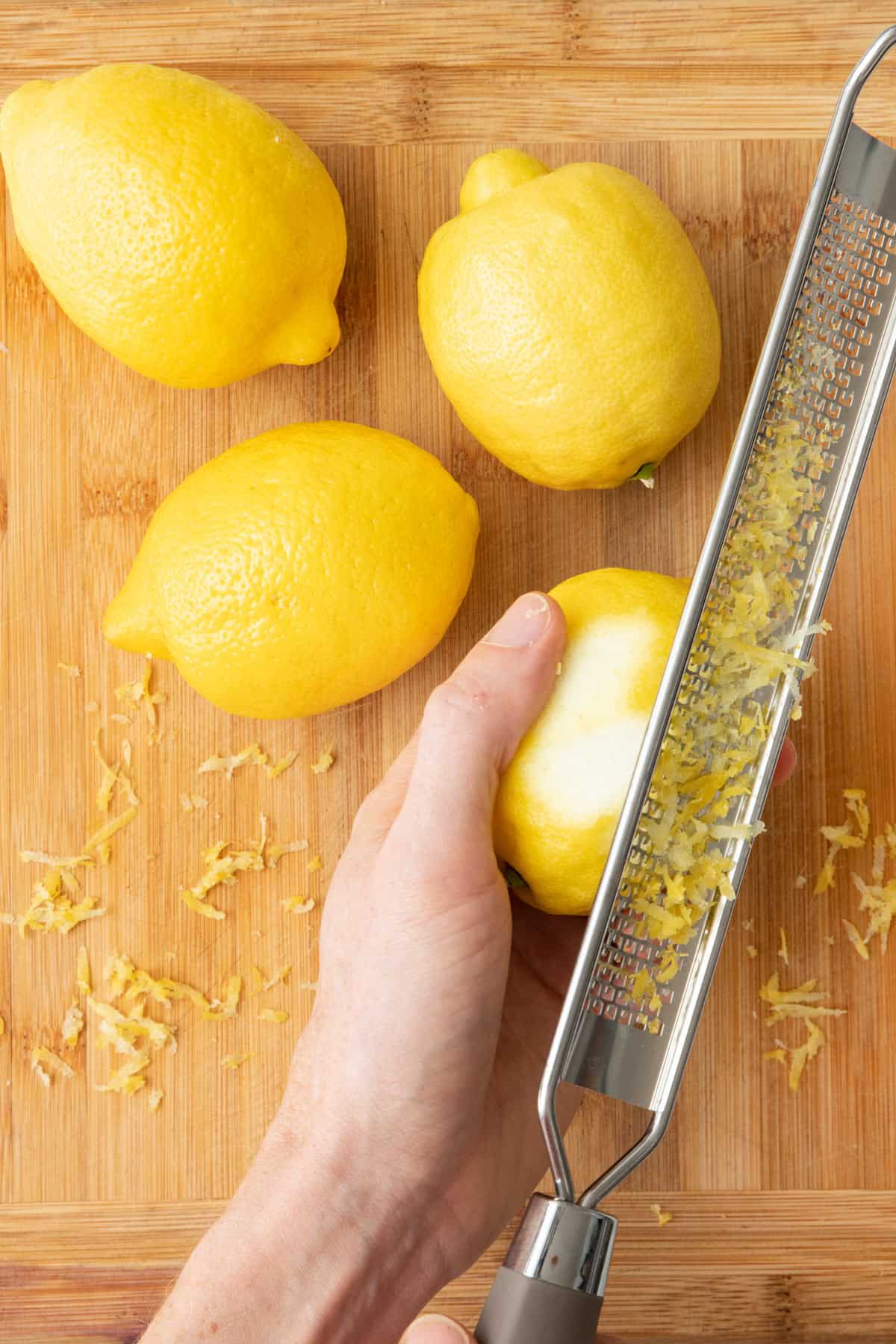
Jump to Section
Zesting a lemon is a simple technique that allows you to extract the flavorful and fragrant outer layer of the lemon peel known as the zest. But how do you zest a lemon? Turns out – very easily! In this easy step-by-step guide, you’ll learn how to make lemon zest at home to take your dishes or beverages to the next level good!
WHY learn how to make lemon zest
- Always be ready to enhance the flavor of any dish. Lemon zest adds complexity and depth to both sweet and savory dishes. It’s an easy way to add a bright and refreshing citrus flavor to any dish.
- Minimize food waste. When you only use the juice of the lemon, you’re left with the discarded lemon peel, which often ends up in the trash or compost bin. By zesting the lemon, you can extract its flavorful peel, give it a new purpose, and reduce unnecessary waste in your kitchen. It’s a win-win!
- Healthier alternative to artificial citrus flavors. Lemon zest provides a pure, concentrated burst of citrus flavor that’s great for all your citrus needs. Skip the flavored drinks and add a touch of lemon zest to your sparkling water for a refreshing afternoon beverage.
- Inviting element that catches the eye. Similar to chopped parsley, lemon zest can serve as a beautiful garnish. It takes a dish up a notch!
tools for zesting lemons
- Microplane: A versatile and handy tool in the kitchen. A microplane grater has a long, narrow, stainless steel blade with sharp edges, and it is commonly used for zesting citrus fruits like lemons, limes, and oranges. It’s also great for hard cheeses, spices, ginger, and garlic.
- Box Grater: Most home cooks are familiar with this tool, and you likely have this in your kitchen right now. It typically has 3 or 4 sides, and you want to use the grater’s small holes to zest a lemon.
- Vegetable Peeler: This is a tool I use for peeling potatoes, carrots, and other vegetables, but it works well for zesting lemons. After peeling the yellow outer layer of the lemon, you can leave them as is or chop them finely.
- Paring Knife: If you don’t have any special tools, you can also use a sharp knife to zest a lemon. This would involve two steps: first, remove the yellow outer layer and then chop the zest finely.
- Citrus Zester: This is a specialized tool with a sharp hole that creates a thin strip of zest that curls. This type of zest is often used to garnish drinks and desserts.
HOW TO zest a lemon 4 ways
You can zest a lemon several ways, so if you don’t have a “zester,” aka Microplane, on hand no need to worry! It is important that you start with a very well-washed and thoroughly dried lemon before you begin removing the outer skin.
From there, choose which one is best suited for your recipe:
How to zest a lemon with a Microplane
- Hold the Microplane zester at a slight angle and gently scrape the lemon’s outer skin, avoiding the white pith underneath.
- Move the zester in long strokes to collect the fine lemon zest. Continue until you’ve zested as much lemon zest as desired. And that is how to zest a lemon with a microplane!
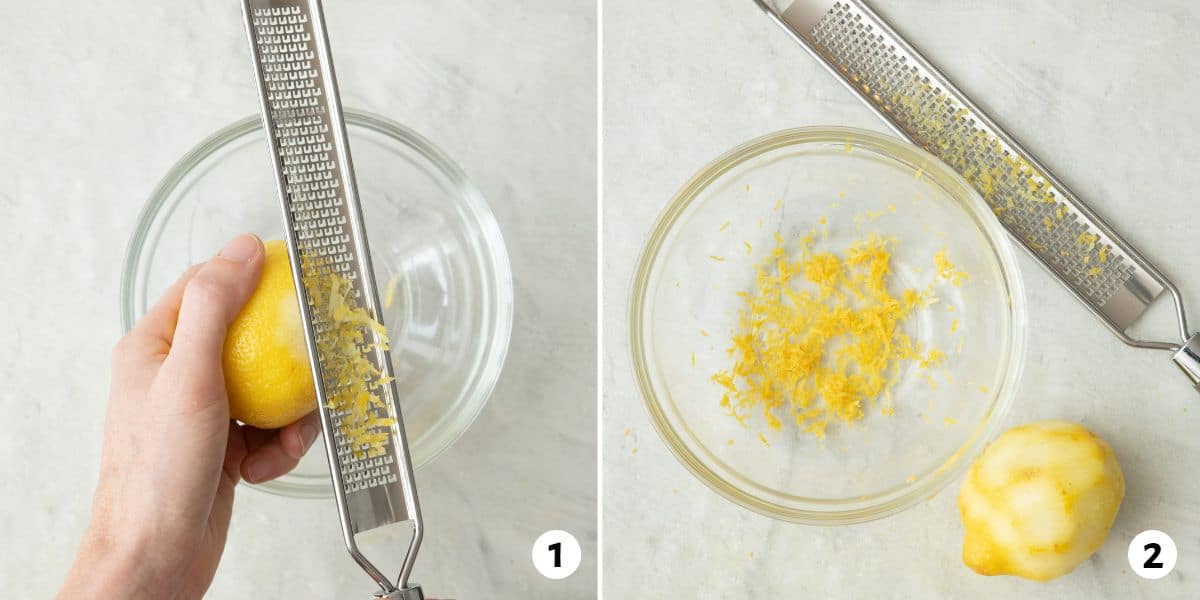
how to zest a lemon with a Box grater
- Rub the lemon against the grater’s small holes. Be careful not to press too hard to avoid grating the bitter pith.
- Continue to grate the lemon’s outer peel until you have the desired amount of lemon zest. And that’s how to zest a lemon with a box grater.
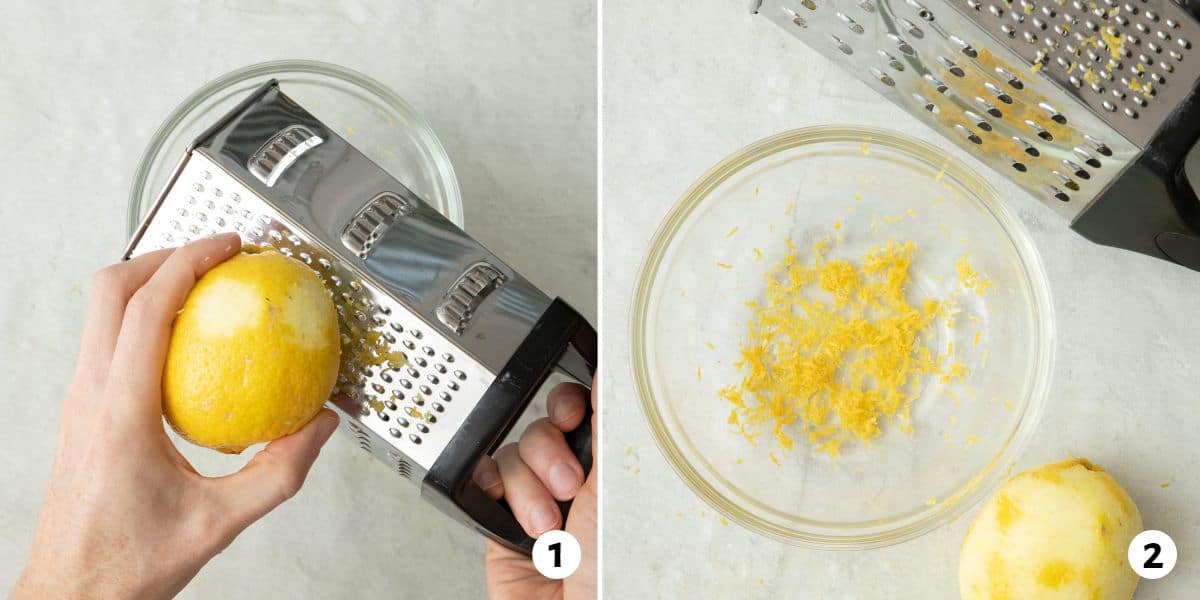
how to zest a lemon with a vegetable Peeler
- Carefully peel off the outer layer with a vegetable peeler, avoiding the white pith. You can use a knife to trim the strips into thinner pieces or leave them as is.
- Continue with the remaining lemon until you have the desired amount of lemon zest. That’s how to zest a lemon with a peeler.
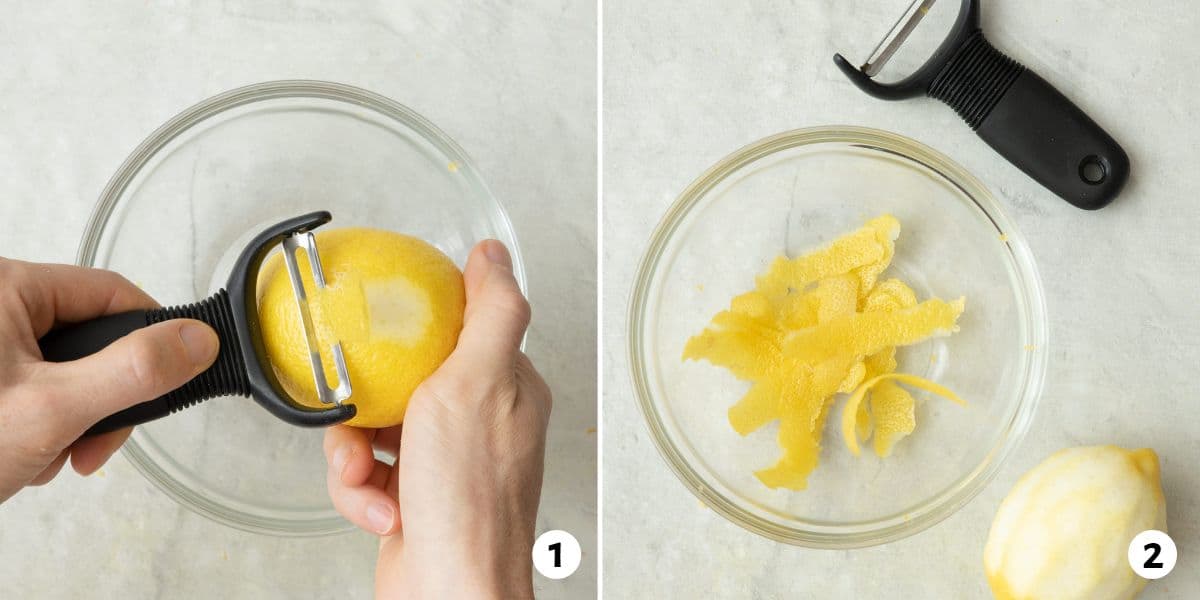
How to use a Knife to zest a lemon
- Use a sharp paring knife to carefully remove the yellow outer layer, avoiding the pith.
- Finely chop the zest with a knife to achieve the desired size.

TIPS FOR zesting a lemon
- Pay attention to whether your lemon has a wax coating. If the lemon is organic, the wax coating is made from beeswax and is perfectly edible. If it is not organic, you’ll want to try to remove that layer of wax by washing the lemon with hot water and then scrubbing it dry vigorously with a kitchen towel.
- Choose a fresh and firm lemon. Look for lemons that are brightly colored and have a firm texture. This indicates they are ripe and will yield more zest.
- Avoid pressing too hard, and rotate the lemon often. No matter what method you use to zest a lemon, it’s important that you apply gentle pressure to remove the yellow zest without digging too deep into the pith. Rotate the lemon as you grate, using different areas of the surface.
- Zest over a bowl or parchment paper. Let the zest fall directly onto parchment paper or a small bowl to save cleanup time.
- Zest, then juice. If a recipe calls for lemon zest and lemon juice, zest first, as removing the zest can be more challenging once the lemon has been cut into and juiced.
- Avoid zesting into the pith. The pith is the white “cushion” under the skin that protects the fruit. It has a very bitter taste that can take your zest from a flavor booster to inedible. So make sure to just zest the surface of the lemon.
recipes to make with lemon zest
- Lemon Blueberry Scones
- Vegan Lemon Bars
- Lemon Herb Shrimp and Rice Bowl
- Grilled Lamb Chops
- Lemon Cucumber Orzo Salad
HOW TO STORE lemon Zest
You can store freshly grated lemon zest in an airtight container or a small glass jar in the refrigerator. Or you can take an extra step and dry the lemon zest for longer storage.
HOW LONG WILL lemon zest LAST IN THE FRIDGE?
When stored properly, lemon zest will last in the fridge for up to a week.
CAN I FREEZE zested lemon?
Yes! Flash freeze the lemon zest first in teaspoon-size portions. Divide the lemon zest into portions on a dish lined with parchment paper and place in the freezer. Once frozen, transfer to a freezer bag and return to freezer for later use—store lemon zest in the freezer for up to 3 months.
FREQUENTLY ASKED QUESTIONS
Any variety of lemon can work well as long as they are fresh, firm, and vibrant yellow. Meyer lemons are a popular choice for their fragrant and subtly sweet flavor. However, they are smaller and have thinner skin than regular lemons, so you might get less zest out of them. Other lemon varieties, such as Eureka and Lisbon lemons, are also great options.
Simply spread the lemon zest in a single layer on a baking dish and place it in a well-ventilated area to air dry for a few days or until it’s dry and brittle. Once completely dry, transfer the zest to an airtight container and store it away from direct sunlight for up to 6 months.
This will depend on the size and type of lemon you are zesting, but generally, one large lemon will yield approximately 1 tablespoon of fresh lemon zest.

That’s all there is to making lemon zest at home. Zesting a lemon is an easy and effective way to elevate your favorite dishes and avoid food waste. With these tips, you can easily zest a lemon without a zester using regular kitchen tools such as a box grater, vegetable peeler, and a paring knife.
MORE kitchen tutorials:
- How to Peel and Cut Fresh Ginger
- How to Cut Garlic
- How to Chop Cilantro
- How to Chop Parsley
- How to Cut Dragon Fruit
- How to Cut Bell Peppers
- How to Cut Mushrooms
- How to Cut Sweet Potatoes
- How to Cut a Head of Lettuce
If you found this tutorial for How to Zest a Lemon helpful or if you try any recipe on Feel Good Foodie, then don’t forget to rate the recipe and leave a comment below! It helps others who are thinking of trying out this tutorial and we would love to hear about your experience. And if you snapped some shots, share it on Instagram so we can repost on Stories!
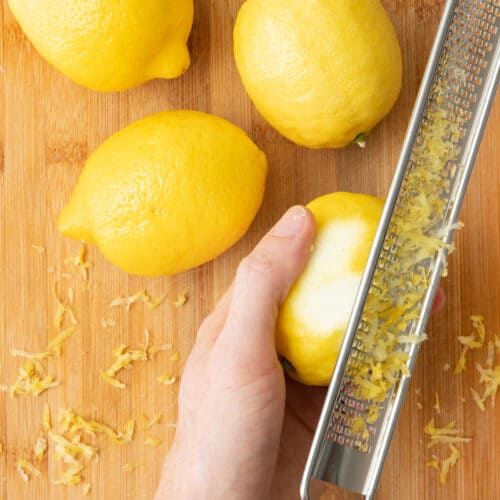
How to Zest a Lemon
Ingredients
- 1 lemon
Instructions
- Wash the lemon thoroughly and dry it.
- Zest the lemon using one of the following techniques:
- Microplane Zest: Hold the microplane zester at a slight angle and gently scrape the lemon's outer skin, avoiding the white pith underneath. Move the zester in long strokes to collect the fine lemon zest.
- Box Grated Zest: Rub the lemon against the grater's small holes. Be careful not to press too hard to avoid grating the bitter pith.
- Peeler Zest: Carefully peel off the yellow outer layer with a vegetable peeler, avoiding the white pith. You can use a knife to trim the strips into thinner pieces or leave them as is.
- Knife Zest: Use a sharp paring knife to carefully remove the yellow outer layer with a knife, avoiding the pith. Finely chop the zest with a knife to achieve the desired size.
Nutrition
Nutrition information provided is an estimate. It will vary based on cooking method and specific ingredients used.





